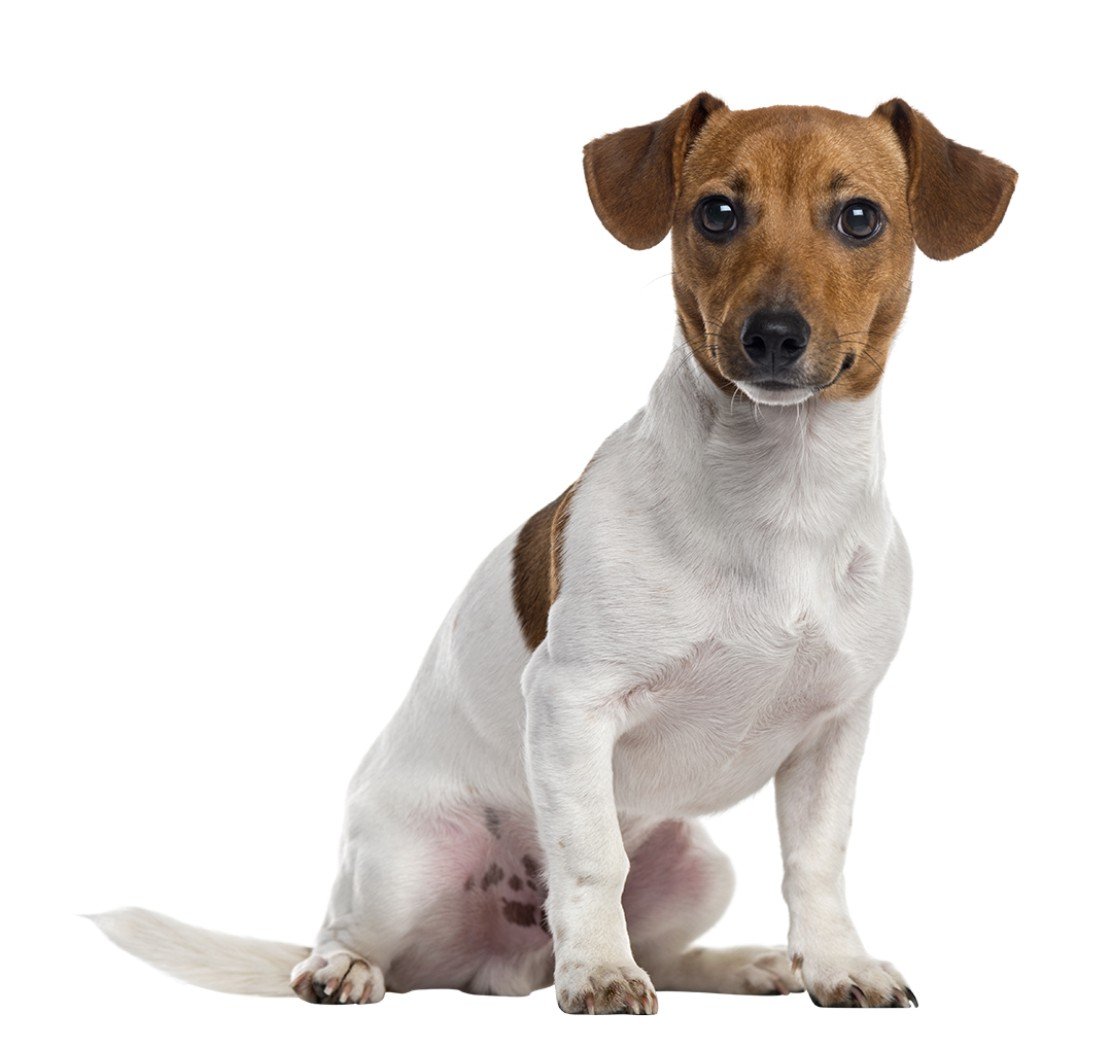Jack Russell Terrier
BREED INFO
- Group – Terrier
- Height – 10-12 inches at the shoulder
- Weight – 6-8 KG
- Life Span – 13-15 years
A strong, active, little working Terrier of great character with flexible body of medium length. His smart movement matches his keen expression. Tail docking is optional and the coat may be smooth, rough or broken.
History

The Jack Russell Terrier was developed in Devonshire, England, in the early 1800’s. In 1819, a young John (Jack) Russell was wandering the Oxford University campus shortly before he was to sit for an examination for which he apparently was ill-prepared. He came across a milkman accompanied by an unusual, but adorable, terrier bitch. Russell found her so delightful that he bought her on the spot and named her “Trump.” Trump became the foundation for the Jack Russell Terrier breed. Based upon her appearance (which was similar to a Wire Fox Terrier but with shorter legs and a wider skull), Trump is thought to have been a cross between a Black-and-Tan Terrier and a Fox Terrier.
After Mr. Russell graduated from Oxford, he bred Trump to create a terrier tall enough to keep up with his hunting foxhounds, but small enough to go to earth and bolt a fox from its den. He deliberately avoided introducing so-called “killer blood,” because he wanted his dogs to set the fox running above ground rather than kill it below ground and ruin the chase. He bred for consistency in temperament, not for consistency in looks. It is thought that he introduced Fox Terriers and perhaps Beagles into the mix. His terriers were also distinctive because they were primarily white, with minimal tan and/or black markings mainly on the head and rump.
After Mr. Russell’s death, his dogs and their descendants became hugely popular with sportsmen, and supposedly were crossed from time to time with Dachshunds, Corgis and assorted toys and terriers, causing considerable variation in size, shape and type. This variability made the breed ineligible for acceptance by The Kennel Club (England) for the show ring, despite being one of the most popular breeds in the British Isles. Breed enthusiasts formed their own Jack Russell Terrier Club of Great Britain in 1974 and organized their own competitive shows.
In the early 1980s, that club split in two: those who wanted to impose a rigid breed appearance standard to appease and gain admittance to The Kennel Club, and those who gave priority to the temperament and working qualities of their terriers. The first group formed the Parson Jack Russell Terrier Club, for purposes of promoting what they called the “Genuine” Jack Russell. They developed their own breed standard and were granted recognition by The Kennel Club in 1989, and by the American Kennel Club in 1997 as a member of its Terrier Group. The Parson Jack Russell is longer-legged and more squarely built than the shorter-legged, slightly longer-bodied and less consistent Jack Russell Terrier. The existing club continued as the Jack Russell Terrier Club of Great Britain, which is not a member of the English or the American Kennel Club even today. The Jack Russell Terrier Club of America was founded in 1976, and today is the largest Jack Russell Terrier breed club and registry in the world
Personality and Temperament
The terrier must present a lively, active and alert appearance. It should impress with its fearless and happy disposition. It should be remembered that the Jack Russell is a working terrier and should retain these instincts. Nervousness, cowardice or over-aggressiveness should be discouraged and it should always appear confident.

The Jack Russell Terrier is a perky, merry, devoted, and loving dog. Spirited and obedient, yet absolutely fearless. Careful and amusing, he enjoys games and playing with toys. Friendly and generally kind to children who have been taught not to tease or strike the dog. They are intelligent, yet willful and determined. They can be slightly difficult to train and need a firm, experienced trainer. The Jack Russell can be aggressive with other dogs if not well trained and socialized.
Hair, Care and Grooming
Smooth, without being so sparse as not to provide a certain amount of protection from the elements and undergrowth. Rough or broken coated, without being woolly. All coat types are easy to groom. Comb and brush regularly with a firm bristle brush, and bathe only when necessary. To show, owners must strip the coat. Like the rough coat, the broken coated Jack needs to be stripped out also.
Health
Some are prone to dislocation of the kneecaps, inherited eye diseases, deafness, Legg Perthes-a disease of the hip joints of small breeds of dogs.
Training and Activity
Because the Jack Russell is so smart, this breed excels in training exercises. Of course, being Terriers, you can expect some stubbornness, but assert yourself as the pack leader and you will succeed with your training endeavors. For the best results, use positive reinforcement and treats to confirm a job well done. If you use harsh discipline, it may cause this dog to respond with snapping or biting. As well, it will help to mix up your daily training routine to keep your Jack Russell Terrier engaged and interested. Once your Jack Russell Terrier has mastered basic obedience, he can move up to advanced obedience, trick training and agility work. This is an overachiever of a breed, so you can expect your Jack Russell to excel in every activity he participates in.

The Jack Russell terrier is very adaptable and will exercise itself in a small yard, but it will be in its glory with space to run, hunt and play.
Feeding
This is one high-energy dog, and as such, you’ll need to feed your Jack Russell Terrier a high-power fuel food. A homemade diet of fresh meat and vegetables would be the best, but for many owners, this is just not possible. If you are going with a commercial food, be sure that the kibble is high quality.






